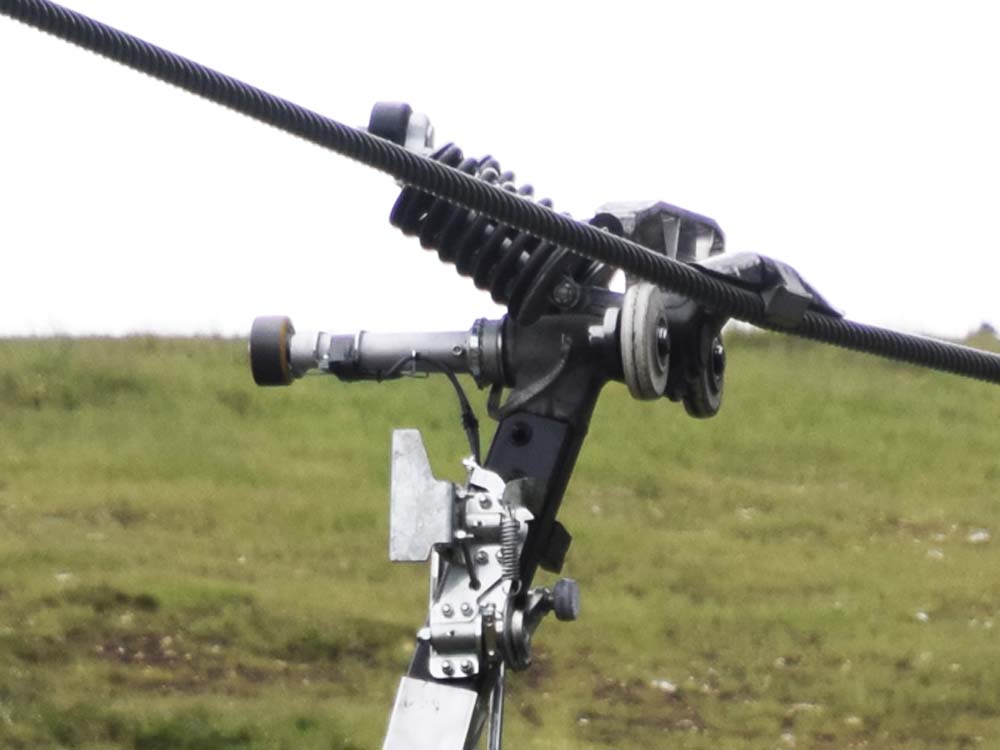Fixed and detachable grips
Why don't cable cars fall off the cables? Compared to the weight they have to carry, the cabins, gondolas and chairs hang on a cable with a relatively small support surface. Yet the gondolas and cabins remain neatly in the right place without sliding back and forth on the cable.
Cable cars are attached to the so-called carrying cable with grips. This cable can serve purely as a carrying cable or as a combination of carrying cable and pulling cable, a so-called Förderseil. There are two types of grips, the so-called fixed grips and the detachable grips.
Fixed grips
A fixed grip, as the name suggests, is gripped to the cable and cannot be released from this cable. Detachable grips can be disconnected from the cable. The very first revolving cable cars only had fixed grips as the detachable grips had not yet been invented. Pendulum cable cars always use fixed grips as they only go back and forth on the same cable. A detachable grip is of no use in this case.
Advantages and disadvantages of a fixed grip
The advantage of a fixed grip is that you do not have to think about how to disconnect the grip from the cable. The grip can be completely integrated with the cable. In addition, it is cheaper than a detachable grip. The major disadvantage of the fixed grip is that, because they cannot be disconnected, the gondolas and chairs maintain the same speed in the stations as during the ride itself. Passengers therefore have to get on and off while the cable car moves around the station at the same speed. Of course, the speed can be adjusted, but this will affect the speed of the entire track. The chairs and gondolas hanging somewhere above a deep ravine also slow down or come to a stop. The result is that the maximum speed of a gondola or chair lift with a fixed grip can never be too high. The maximum hourly capacity of what the cable car can transport is therefore also limited. In addition, the size of the chair lifts seat is also limited. Because the speed remains the same, the chairs also move around the drive unit at a fixed speed. The higher the speed, the more forces are released while rotating around the disk. Larger chairs obviously have more weight and the centrifugal forces are therefore too great. A single seat or a double seat is possible, but larger variants are virtually excluded.
Detachable grips
Unlike fixed grips, a detachable grip can be removed from the cable. As soon as a gondola or chair enters the station, the grip is opened and the gondola continues on a track. The carrying cable to which the gondola was attached simply continues at the same speed. The rail that takes over the gondola from here moves much slower so that passengers can get in and out relatively quietly. Once the passengers have boarded and the doors in the case of a gondola are closed, the gondola is brought back up to speed and as soon as the speed is equal to the speed of the carrying cable, rotating at a fixed speed, the gondola or the seat is reconnected to the cable.
How does a detachable grip work?
When a gondola or chair wants to leave the station, the grip is still disconnected from the carrying cable. The gondola moves through the station on a rail. To bring the gondola up to the speed of the cable, the gondola is then propelled via a kind of intermediate piece with large wheels. The spring of the grip is pressed, causing the grip to open. The grip is pressed down via a guide system so that it moves around the grip. The spring is then slowly released again so that the grip closes again, but this time around the cable. The gondola is now attached to the cable and will be removed from the cable in the same way, vice versa, at the next station.
History of the detachable grip
Over the years, several cable car manufacturers have made detachable grips. For example, there are the detachable grips developed by Van Roll in 1940, the so-called VR101 grips. These VR101 grips worked based on gravity in combination with a spring. Van Roll's detachable grip has the so-called grip housing attached on top of the cable, which means that so-called low-level supports or pillars cannot be used with these grips. The cable passes underneath these supports. This means that the support located directly at the valley station must also be a high-support support.
Another well-known system for detachable grips is the system developed by Engineer Gerhard Müller, the so-called System Müller detachable grip. The System Müller was one of the first systems with detachable grips. The first cable car with a System Müller grip was the Sattel-Hochstuckli chairlift, which opened in 1950. The big advantage of this grip was that only 1 cable was needed that could be used as both a carrying and pulling cable. Until this time, systems with separate carrying cables and pulling cables were usually used. With the System Müller grip, the grip is opened and closed using a drive wheel. The gondola is brought up to speed in the station and placed on the cable and the grip is then closed using the drive wheel.
Newer systems work with so-called board springs that ensure that the grip opens and closes in the stations.
Want to know more about the different cable car types or cable car terminology?





